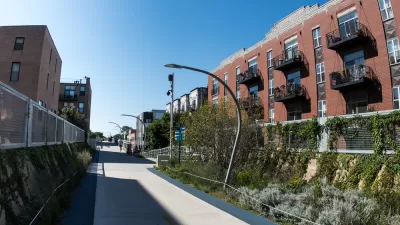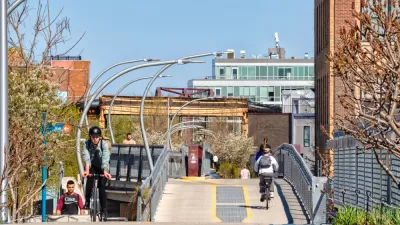That beautiful new bike lane, known as the 606, in Chicago has brought along with it local concerns about gentrification. The city and a local non-profit have teamed up to create a loan program to help current residents stay ahead of the curve.
"If you build a beautiful trail that winds through the city's hippest neighborhoods, they will come," writes Paul Biasco. "But a new program aimed at fighting gentrification around the 606 wants to make sure 'they' won't force longtime residents out of their homes."
Neighborhood Housing Services "is helping longtime residents living within a strict boundary around the elevated trail apply for $25,000 in "forgivable" loans to fix up their homes," according to Biasco. "The $1 million program is designed for modest-income homeowners and aims to preserve affordability along the trail."
The program received its funding from the city of Chicago. According to Biasco, the "Chicago Department of Planning and Development implemented the $1 million program, which is using funds from the city's Neighborhood Loan Program." The article includes more details about the real estate market context of the neighborhoods around the 606, which have already seen substantial new investment proposals from developers looking to capitalize on the new amenity, and the resulting fears of gentrification.
FULL STORY: As Area Near 606 Gentrifies, Loans Give Longtime Humboldt Residents Hope

Maui's Vacation Rental Debate Turns Ugly
Verbal attacks, misinformation campaigns and fistfights plague a high-stakes debate to convert thousands of vacation rentals into long-term housing.

Planetizen Federal Action Tracker
A weekly monitor of how Trump’s orders and actions are impacting planners and planning in America.

In Urban Planning, AI Prompting Could be the New Design Thinking
Creativity has long been key to great urban design. What if we see AI as our new creative partner?

Milwaukee Launches Vision Zero Plan
Seven years after the city signed its Complete Streets Policy, the city is doubling down on its efforts to eliminate traffic deaths.

Portland Raises Parking Fees to Pay for Street Maintenance
The city is struggling to bridge a massive budget gap at the Bureau of Transportation, which largely depleted its reserves during the Civd-19 pandemic.

Spokane Mayor Introduces Housing Reforms Package
Mayor Lisa Brown’s proposals include deferring or waiving some development fees to encourage more affordable housing development.
Urban Design for Planners 1: Software Tools
This six-course series explores essential urban design concepts using open source software and equips planners with the tools they need to participate fully in the urban design process.
Planning for Universal Design
Learn the tools for implementing Universal Design in planning regulations.
Gallatin County Department of Planning & Community Development
Heyer Gruel & Associates PA
JM Goldson LLC
City of Camden Redevelopment Agency
City of Astoria
Transportation Research & Education Center (TREC) at Portland State University
Jefferson Parish Government
Camden Redevelopment Agency
City of Claremont




























